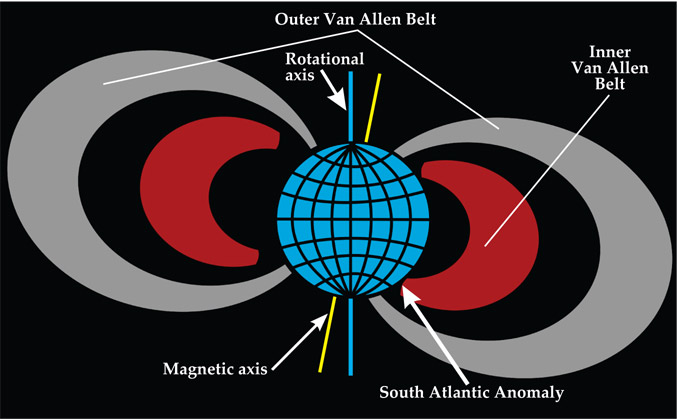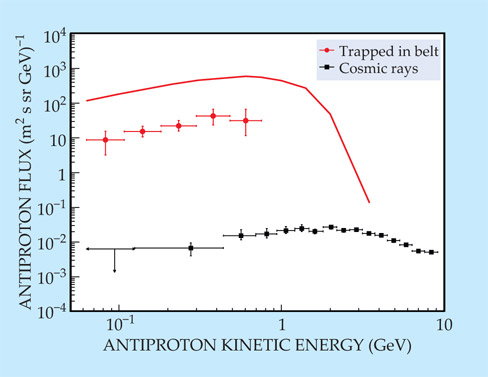A belt of magnetically trapped antiprotons girdles Earth
DOI: 10.1063/PT.3.1282
The satellite-borne spectrometer PAMELA, launched in 2006, is particularly good at detecting charged antimatter particles: positrons (e+) and antiprotons (p‾). Last year the PAMELA collaboration, led by Piergiorgio Picozza (University of Rome, Tor Vergata), reported a precision measurement of the minuscule p‾ component of the spectrum of cosmic rays arriving at the top of the atmosphere. The measured p‾ flux, the team found, could be explained by p‾ production in high-energy collisions of cosmic-ray nuclei with ordinary interstellar matter. 1 So there was as yet no evidence of exotic sources of cosmic-ray antiprotons.
A similarly prosaic explanation holds for PAMELA’s latest discovery: a significant p‾ population magnetically trapped in Earth’s inner Van Allen radiation belt. 2 The flux of trapped p‾s spiraling around the belt’s geomagnetic field lines turns out to be a thousand times greater than the flux of cosmic-ray p‾s entering the atmosphere. That makes PAMELA’s discovery the greatest concentration of antimatter yet observed. Even so, the team concludes that the trapped p‾ population is readily explained by collisions in the atmosphere of cosmic-ray protons energetic enough to create neutron–antineutron pairs. In fact, the antiproton component of the Van Allen radiation belt had long been predicted and looked for, but only now has it been found.
Trapped in the inner belt
The inner Van Allen belt, characterized by its high concentration of trapped protons with kinetic energies up to a few GeV, does not extend down into the atmosphere. As shown in figure 1, it ranges in altitude from a few hundred kilometers near the magnetic poles to 10 000 km near the magnetic equator. Trapped protons spiral left-handedly around the lines of Earth’s dipole field as they drift along them, bouncing back and forth between north and south magnetic-mirror points created by the field lines’ convergence toward the poles.

Figure 1. The Van Allen radiation belts, shown here in cross section roughly to scale, wrap around Earth above the atmosphere with axial symmetry about the geomagnetic axis. The inner belt is characterized by its trapped population of sub-GeV protons. The magnetic axis is tilted 10° from the rotation axis and the center of the dipole field is offset from the planet’s center by 560 km. As a result, the inner belt comes closest to Earth’s surface between South America and South Africa, creating the so-called South Atlantic Anomaly. That’s the only region where the PAMELA spectrometer, orbiting with a maximum altitude of 600 km, can access the inner belt in its search for trapped antiprotons.

Antiprotons entering the inner belt would become similarly trapped, if they arrived with sufficiently low energy and in a direction roughly orthogonal to the local magnetic field. But being negatively charged, they would spiral right-handedly. Annihilating encounters with resident protons would be rare in the relative vacuum of the belt. But where would a sufficient p‾ influx come from to account for PAMELA’s observation? The p‾ component of the cosmic-ray spectrum is much too small.
Predictions of a trapped p‾ population in the inner belt invoked the creation of antineutrons (n‾) in the pair-production reaction
p + p → p + p + n‾ + n,
instigated in atmospheric nuclei by cosmic-ray protons with energies above a threshold of about 7 GeV. Like a free neutron, an antineutron will beta decay into its charged partner with a half-life of 10 minutes. But why single out this circuitous route to the p‾ when cosmic-ray collisions in the atmosphere also produce pp‾ pairs directly? The reason is that as it plows through the atmosphere, a charged p‾ loses energy faster than a neutral n‾ and therefore is much less likely climb out to the inner belt before annihilating.
The trapped p‾ population thus created would maintain a steady-state population—at least for a given phase in the 11-year solar cycle, which causes Earth’s atmosphere to expand and contract—by continuous annihilation losses that equilibrate with the trapping of newly created low-energy p‾s.
The orbiting spectrometer
PAMELA’s principal component is a tracking magnetic spectrometer half a meter long (see PHYSICS TODAY, May 2011, page 10
In its elliptical, quasi-polar orbit, which ranges in altitude from 350 to 600 km, PAMELA encounters the inner radiation belt only in the region of the so-called South Atlantic Anomaly (SAA), where the belt has its lowest altitude and orbiting craft take special precautions against the region’s notorious radiation level. The magnetosphere is more-or-less azimuthally symmetric about the Earth’s magnetic axis. But its 10° inclination from the rotation axis and the dipole’s 560-km offset from Earth’s center create geographically asymmetrical features like the SAA.
PAMELA spends less than 2% of its orbiting time in the SAA. So in almost three years of data taking for the new paper, it dwelt among the trapped protons and antiprotons for only a few hundred hours. And in that time, it recorded only 28 particles that passed all the team’s tests for identifying a true trapped p‾. Among those tests was the requirement that the incident particle’s pitch angle—the angle between its momentum and the local magnetic field lines—be close to 90°, as predicted by model simulations of the spiraling of trapped protons and antiprotons. Indeed PAMELA’s momentum measurements were good enough to allow each p‾ candidate particle’s trajectory to be extrapolated backwards in time for thousands of kilometers in the well-mapped magnetosphere, to check that its journey to the detector was compatible with that of a trapped p‾.
The measured spectrum
”The hard part,” says PAMELA team member Alessandro Bruno (University of Bari, Italy), “is translating the handful of p‾s actually recorded by our small detector into estimates of the actual flux spectrum in the SAA.” The task is complicated by the intrinsic anisotropy of the tapped p‾ flux. Aside from the pitch-angle constraint on the spiraling motion, there’s also an interesting east–west asymmetry: Spiraling right-handedly with gyroradii of order 100 km around field lines pointing mostly north, p‾s arriving at the detector from the west have mostly just risen from lower altitudes. So their numbers have been depleted relative to those arriving from the east—and therefore mostly from above—by encounters in the upper atmosphere.
The detector has its own anisotropy. The effective aperture size depends not only on the particle’s energy but also on its incident direction relative to the spectrometer’s axis. Convolving the intrinsic and instrumental anisotropies and taking note of PAMELA’s location and orientation at each of the 28 p‾ captures, the team arrived at the trapped-p‾ flux spectrum shown in figure 2. What’s plotted is, in effect, the flux through the local plane whose orientation maximizes the flux. Because of the near-90° spiraling, that plane generally includes the field line.

Figure 2. The flux spectrum of antiprotons trapped in Earth’s inner Van Allen belt is compared with a prediction (solid curve) based on a theoretical model3 and with the much smaller flux of cosmic-ray antiprotons at energies below 1 GeV. Both spectra were measured by the PAMELA orbiting spectrometer. (Adapted from ref.

In its brief visits to the SAA, PAMELA recorded no trapped p‾s with kinetic energy above 1 GeV. Beyond that energy, theoretical models expect the population to fall precipitously, reflecting the increasing difficulty of keeping an energetic particle trapped. The curve in figure 2 shows the expected p‾ flux spectrum based on a model by theorist Richard Selesnick and coworkers. 3 The model expectation exceeds the measured flux out to 1 GeV by about a factor of 10. “That’s considerably bigger than our estimated 10% systematic uncertainty [not included in the plotted statistical error bars],” says team member Francesco Cafagna (National Institute of Nuclear Physics, Bari). “Probably the four-year-old model just needs some fine tuning.”
Much starker is the contrast in figure 2 between the flux of trapped p‾s and the flux of cosmic-ray p‾s, also measured by PAMELA. In the energy range over which both have now been measured, the former dwarfs the latter by three orders of magnitude.
When the public press first reported the discovery of antimatter trapped so close by, there was much loose talk that it might one day serve as a fuel source for spacecraft. But any plausible integration of the PAMELA findings over the entire inner Van Allen belt yields a total p‾ mass of only a few nanograms. Its complete annihilation would provide about as much energy as eating a banana or two.
So, aside from the discovery and its gratifying confirmation of a decades-old expectation, what’s the use of studying the trapped p‾s? The detailed radiation perils of traversing the inner Van Allen belt are already known well enough from the trapped-proton data. But because of the roundabout way trappable p‾s have to be created, they provide a unique test of models of cosmic-ray transport in the atmosphere and the radiation belts. “The more you learn about local effects,” says Cafagna, ”the better you can disentangle them from galactic phenomena.”
References
1. O. Adriani et al., Phys. Rev. Lett. 105, 121101 (2010). https://doi.org/10.1103/PhysRevLett.105.121101
2. O. Adriani et al., Astrophys. J. Lett. 737, L29 (2011). https://doi.org/10.1088/2041-8205/737/2/L29
3. R. S. Selesnick, et al.,Geophys. Res. Lett. 34, 20 (2007).




